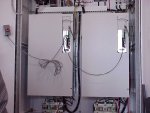For the VFD connected to the load side motor to function, it has to be connected to the line because it is going to supply the flux current to the load motor, then it would be given a speed command that is slightly below the speed the load motor motor is being driven by the line side motor / VFD. The load side motor cannot power up the load side VFD (unless there is some significant residual magnetism, but that can't be counted on). So you will still have the line losses of both VFDs, assuming 3% each, then the losses in those filters and of course both motors. I think 10% total is likely a low estimate, unless that was not counting the losses in the motors, because those exist no matter what.
That makes me think though; now with PMAC motors, I believe that COULD actually be done without any line connection of the load side VFD. In other words the load side motor, as a PMAC motor with Internal or Surface Mount Permanent magnets, COULD in fact act as a generator from the outset, so the VFD connected to it could be powered BY it, then the VFD would give it the lower speed command to make it a load. All you would have would be the losses in the line side VFD then. Kind of a moot point in this case though, nobody I know of is making a 450HP PMAC motor yet.




